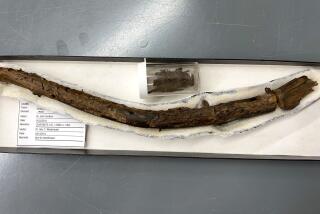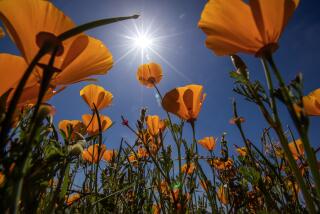The season’s brightest bulb
Few plants confirm the onset of winter more boldly than a tightly potted amaryllis bulb with magnificent flaring Christmas-red flowers. And, alas, few living things are less appreciated once the festivities end.
These grand and giving potted bulbs are first forced to flower on demand, then are rudely discarded by Easter. In fact, they’ll live on and on with little attention, given a warm spot outdoors in the garden -- and will flower each year with bravado.
The hybrids that we call “amaryllis” are technically named Hippeastrum, a label that reveals their South American heritage. By any appellation, they’re worthy of more space. Though pretty as prima donnas, they perform like Eagle Scouts. And they have excellent memories. Once planted out, they revert to their natural spring-flowering cycle, and in many cases, stay evergreen as long as there’s water and food.
“Hipps,” as they’re sometimes called, have been bred almost without pause by infatuated amateurs and professionals since the late 18th century. Heritage hybrids, including the first Hippeastrum X johnsonii (1799), are still in the trade -- and settled into old regional gardens.
Fast forward to new crosses with unconventional forms and colors that have hit the market in the last decade. Even so, breeders still seek to improve plant vigor, fragrance and additional stems and flowers.
Holland and South Africa are the mega-centers for amaryllis breeding and production, with Israel in their slipstream, but many of the finest hybrids hail from California and Florida.
Local notables include the late Fred Meyer of San Diego whose innovative legacy includes fragrant trumpet-shaped miniatures intended for the cut-flower market, and weird and wonderful cybister hybrids.
“Fred had thousands in all different shades and colors, and smaller plants with more flowers per scape,” says Dylan Hannon, a bulb specialist and the new curator of conservatory and tropical collections at the Huntington Botanical Gardens. “He was crossing Dutch hybrids with species Hippeastrums for amazing color patterns, shapes and fragrances.”
Meyer’s trumpet-flowered ‘Amputo’ is highly scented and resembles an Easter lily. His ‘Melusine’ sports larger, flared cream and pink blossoms.
‘Ruby Meyer,’ a cybister cross with narrow, curving wine-red petals is a favorite of Jim Threadgill, owner of Easy to Grow Bulbs, a new mail-order firm specializing in bulbs that naturalize in warm-weather gardens.
Alan Meerow, a research geneticist at the U.S. Department of Agriculture in Miami, is a key breeder of amaryllis hybrids for landscape use. His comprehensive DNA studies of the amaryllis family are challenging thoughts on the group’s evolution and relationships.
But as president of the International Bulb Society (www.bulbsociety.org), Meerow is giddy about collecting forays to the wilds of Brazil for rare Hippeastrums and their beautiful kin. One, he hopes, may hold the key to the first true yellow hybrid. Meerow and Hannon also believe that discovery, propagation and sharing of these scarce bulbs -- whose natural habitats are rapidly diminishing -- may be the only way to prevent their extinction.
Threadgill, who dumped his “tie, suit and commute” for a life in horticulture, seeks out and promotes new varieties. Still, he’s a sucker for old classics such as ‘Red Lion,’ ‘Appleblossom’ and ‘Picotee,’ a white with sharply defined red edges. He’s grown them all outdoors in good and bad soils and watched them multiply. “In cool coastal climates and blistering-hot inland deserts,” Threadgill says.
He does baby them a little with regular water and feeding. “I hate to make work for people, but plants respond to fertilizer, and Hippeastrums are no exception.” He feeds monthly with a liquid fertilizer diluted to one-quarter to one-half strength.
Amaryllis like crowding, especially in containers. Hannon suggests pots that are double the width of the bulbs and a coarse fast-draining mix (one labeled for cactus is good). Bury half of the long-necked bulb, add water and, like magic, a succulent spike of fat buds will emerge, followed by dark, strapping foliage and vivid blossoms.
Once holiday trimmings and the flowers fade, don’t chuck the bulb. Take the pot outdoors or plant its contents in the ground. The spring after next it will flower again, and for many springs to come.
Sally Ferguson, director of the Netherlands Flower Bulb Information Center, envies our amaryllis-friendly climate: Her bulbs must be carefully coaxed back to life each year -- in her Brooklyn basement. She’s diligent, though, because she loves using them as cut flowers.
“Their vase life is two weeks and up. ‘Jewel’ is elegant, with faintly scented double-centered fluttering white petals. The cybisters are really interesting when viewed up close. And they all do this wonderful thing: When you cut the tubular stems, the bottom edges curve up underwater like Persian slippers. They stand themselves up on little curled feet!”
Amaryllis. Hippeastrum. It doesn’t really matter what you call these versatile plants. Come the new year, just treat them kindly and keep the bulbs growing. They’ll reward and delight for a very long time.
*
(BEGIN TEXT OF INFOBOX)
A flowering family
The Amaryllidaceae family includes Hippeastrum -- which most gardeners call “amaryllis” -- and many other bulbs. Here are a few of the best for Southern California gardens.
Naked lady (Amaryllis belladonna): Tall bare stems with pink (sometimes white) trumpets emerging in late summer.
Clivia species: Bulletproof evergreen plants with rhizomes (no bulbs) and trumpet-shaped or tubular red, orange, yellow flowers.
Marsh lily (Crinum species): Handsome foliage, thick stalks and stupendous fragrant flowers.
Haemanthus species: Rare plants with fall or winter brush-like blossoms.
Spider lily (Hymenocallis species, also called Peruvian daffodil): Exotic fragrant summer flowers that scream “jungle.”
Summer snowflake (Leucojum aestivum): Great landscape subject with dark foliage and small drooping flowers in spring ( despite common name).
Narcissus (Narcissus species): Familiar favorites jonquil and daffodil, and numerous less-known charmers, flower from early autumn into spring.
Oxblood lily (Rhodophiala bifida): A clumping 18-inch-tall sun lover with bright red flowers in late summer or early autumn.
Aztec lily (Sprekelia formosissima): A foot-high species with velvety red orchid-like flowers in late spring or early summer.
Autumn daffodil (Sternbergia lutea): A reliable species with thin grassy foliage and deep yellow crocus-like blossoms in autumn.
Lili Singer can be reached at home@latimes.com.






